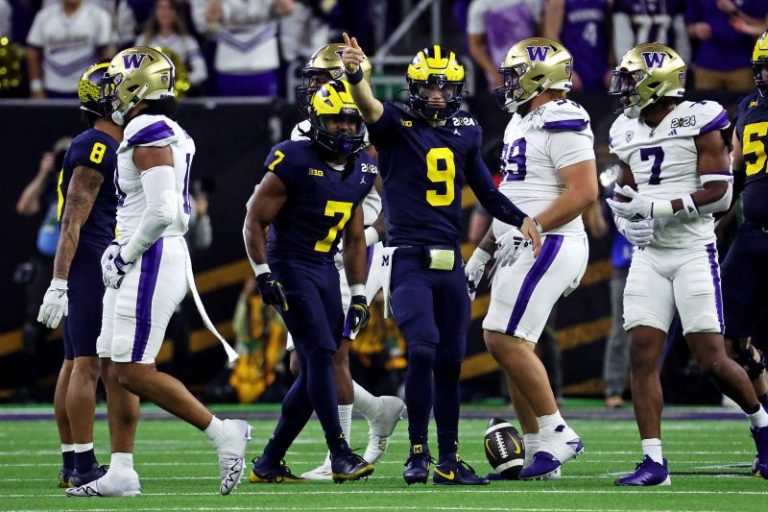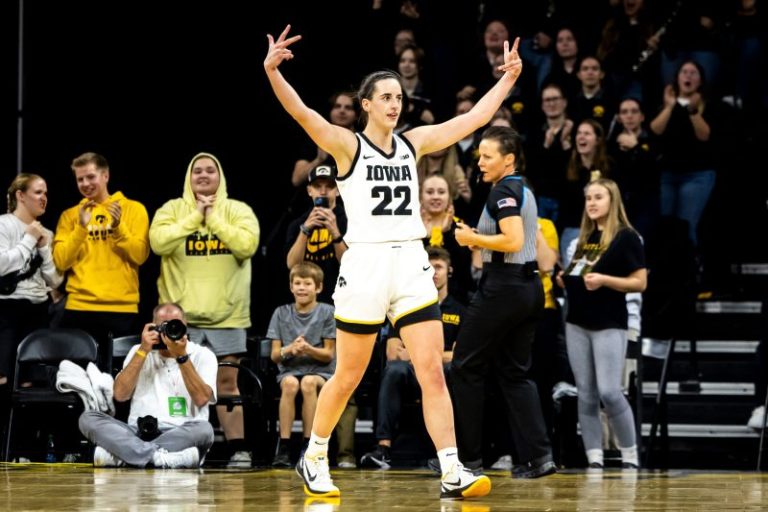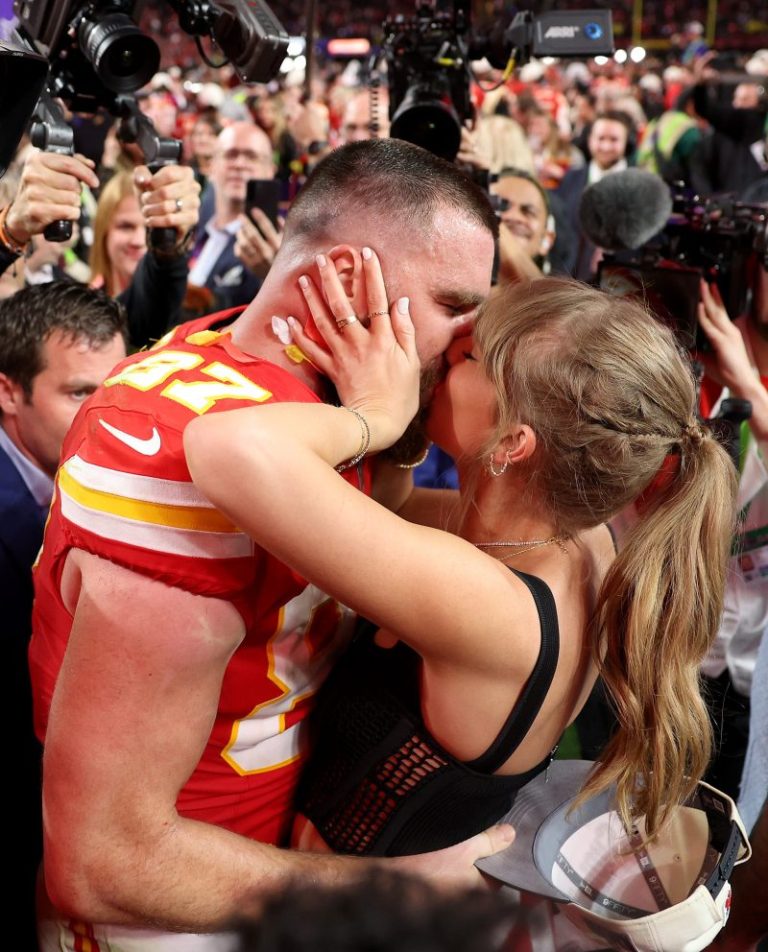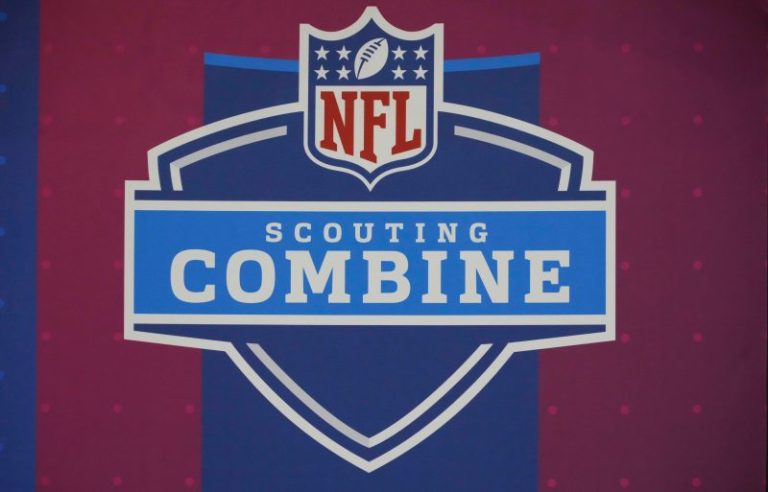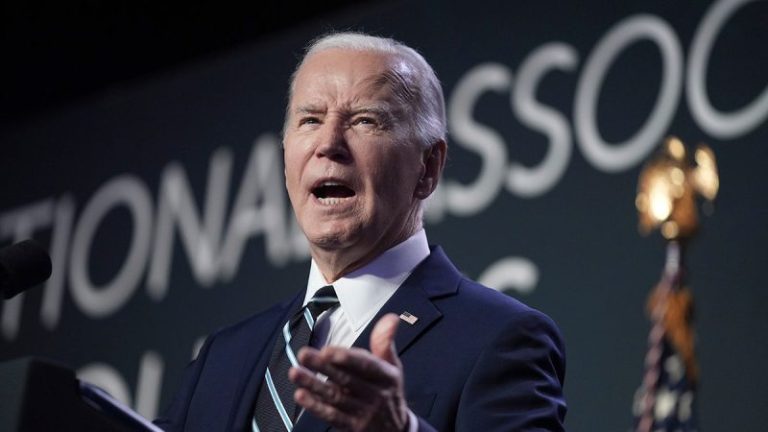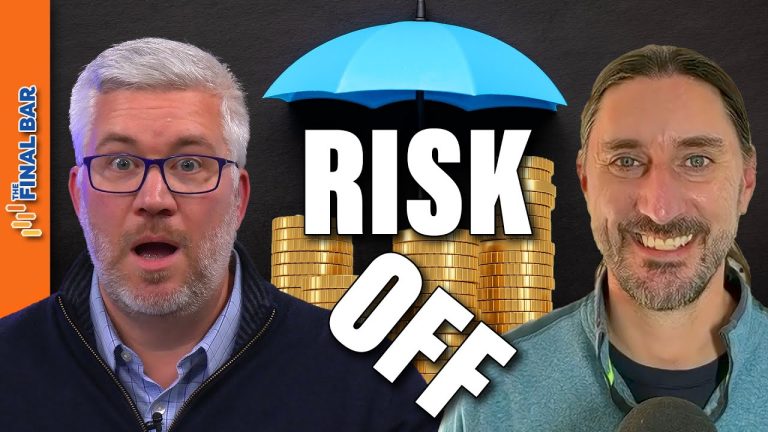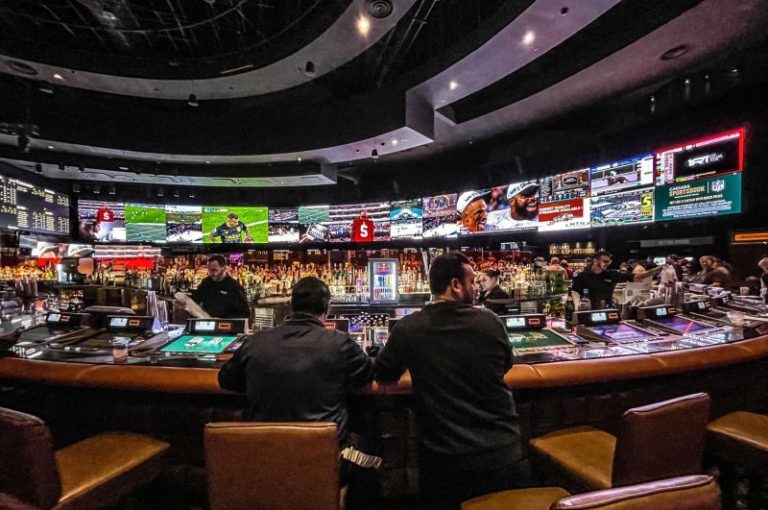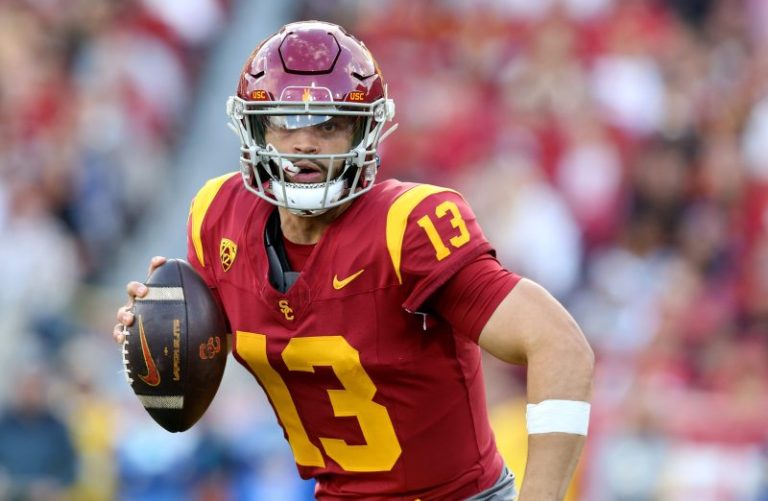On Tuesday, the NFL released the list of 2024 draft prospects who were invited to the scouting combine.
The annual event is a pivotal showcase for the prospects in that year’s draft, with team general managers, head coaches, positional coaches and scouts all gathering in Indianapolis to get an up-close-and-personal look at the prospective NFL players. In addition to on-field testing drills, prospects will be medically examined and official heights and weights taken by the league.
It should come as no surprise, but college football national champion Michigan had the most players invited to this year’s combine with 18.
2024 NFL DRAFT ORDER: All 32 first-round selections set after Super Bowl 58
MOCK DRAFT: Super Bowl champs get a major weapon at wide receiver
NFL STATS CENTRAL: The latest NFL scores, schedules, odds, stats and more.
Here’s everything you need to know for the 2024 NFL scouting combine:
When is the 2024 NFL scouting combine?
The combine will begin on Monday, Feb. 26 and run through Monday, March 4. On-field workouts start on Thursday, Feb. 29.
NFL Network will air the workouts, with streaming available on NFL+.
Where will the NFL combine be in 2024?
The NFL scouting combine will be held in Indianapolis, Indiana, which has hosted the pre-draft event since 1987. The combine events will take place at Lucas Oil Stadium, home of the Indianapolis Colts.
How many players get invited to the NFL combine?
This year, there were 321 prospects invited to the NFL scouting combine.
NFL scouting combine 2024: Which players were invited?
QUARTERBACKS
Jayden Daniels, LSU
Sam Hartman, Notre Dame
Devin Leary, Kentucky
Drake Maye, North Carolina
J.J. McCarthy, Michigan
Joe Milton III, Tennessee
Bo Nix, Oregon
Michael Penix Jr., Washington
Michael Pratt, Tulane
Spencer Rattler, South Carolina
Austin Reed, Western Kentucky
Kedon Slovis, BYU
Jordan Travis, Florida State
Caleb Williams, USC
RUNNING BACKS
Rasheen Ali, Marshall
Braelon Allen, Wisconsin
Emani Bailey, TCU
Trey Benson, Florida State
Jonathon Brooks, Texas
Blake Corum, Michigan
Isaiah Davis, South Dakota State
Ray Davis, Kentucky
Daijun Edwards, Georgia
Audric Estimé, Notre Dame
Frank Gore Jr., Southern Mississippi
Isaac Guerendo, Louisville
George Holani, Boise State
Bucky Irving, Oregon
Dillon Johnson, Washington
Jawhar Jordan, Louisville
Dylan Laube, New Hampshire
MarShawn Lloyd, USC
Jase McClellan, Alabama
Kendall Milton, Georgia
Keilan Robinson, Texas
Cody Schrader, Missouri
Will Shipley, Clemson
Jaden Shirden, Monmouth
Tyrone Tracy Jr., Purdue
Kimani Vidal, Troy
Michael Wiley, Arizona
Miyan Williams, Ohio State
Jaylen Wright, Tennessee
WIDE RECEIVERS
Javon Baker, UCF
Jermaine Burton, Alabama
Jalen Coker, Holy Cross
Keon Coleman, Florida State
Malachi Corley, Western Kentucky
Jacob Cowing, Arizona
Ryan Flournoy, Southeast Missouri State
Troy Franklin, Oregon
Anthony Gould, Oregon State
Lideatrick Griffin, Mississippi State
Marvin Harrison Jr., Ohio State
Jha’Quan Jackson, Tulane
Cornelius Johnson, Michigan
Xavier Legette, South Carolina
Luke McCaffrey, Rice
Ladd McConkey, Georgia
Jalen McMillan, Washington
Bub Means, Pittsburgh
Adonai Mitchell, Texas
Malik Nabers, LSU
Rome Odunze, Washington
Ricky Pearsall, Florida
Ja’Lynn Polk, Washington
Brenden Rice, USC
Tayvion Robinson, Kentucky
Marcus Rosemy-Jacksaint, Georgia
Ainias Smith, Texas A&M
Brian Thomas Jr., LSU
Jamari Thrash, Louisville
Devaughn Vele, Utah
Devontez Walker, North Carolina
Malik Washington, Virginia
Tahj Washington, USC
Xavier Weaver, Colorado
Jordan Whittington, Texas
Isaiah Williams, Illinois
Johnny Wilson, Florida State
Roman Wilson, Michigan
Xavier Worthy, Texas
TIGHT ENDS
Erick All, Iowa
AJ Barner, Michigan
Jaheim Bell, Florida State
Brock Bowers, Georgia
Devin Culp, Washington
Dallin Holker, Colorado State
Theo Johnson, Penn State
Trey Knox, South Carolina
Tanner McLachlan, Arizona
Tip Reiman, Illinois
Ja’Tavion Sanders, Texas
Ben Sinnott, Kansas State
Brevyn Spann-Ford, Minnesota
Cade Stover, Ohio State
Jack Westover, Washington
Jared Wiley, TCU
OFFENSIVE LINEMEN
Isaiah Adams, Illinois
Joe Alt, Notre Dame
Kiran Amegadjie, Yale
Gottlieb Ayedze, Maryland
Karsen Barnhart, Michigan
Graham Barton, Duke
Cooper Beebe, Kansas State
Keaton Bills, Utah
Tanor Bortolini, Wisconsin
Javion Cohen, Miami (Fla.)
Andrew Coker, TCU
Brandon Coleman, TCU
Frank Crum, Wyoming
Anim Dankwah, Howard
Ethan Driskell, Marshall
Kingsley Eguakun, Florida
Josiah Ezirim, Eastern Kentucky
Olumuyiwa Fashanu, Penn State
Troy Fautanu, Washington
Blake Fisher, Notre Dame
Jeremy Flax, Kentucky
Javon Foster, Missouri
Zach Frazier, West Virginia
Taliese Fuaga, Oregon State
X’Zauvea Gadlin, Liberty
Nick Gargiulo, South Carolina
Delmar Glaze, Maryland
Matt Goncalves, Pittsburgh
Tylan Grable, UCF
Garret Greenfield, South Dakota State
Tyler Guyton, Oklahoma
C.J. Hanson, Holy Cross
Christian Haynes, Connecticut
LaDarius Henderson, Michigan
Christian Jones, Texas
Matthew Jones, Ohio State
Trente Jones, Michigan
Trevor Keegan, Michigan
Jarrett Kingston, USC
Brady Latham, Arkansas
JC Latham, Alabama
Sataoa Laumea, Utah
Matt Lee, Miami (Fla.)
KT Leveston Jr., Kansas State
Beaux Limmer, Arkansas
Christian Mahogany, Boston College
Mason McCormick, South Dakota State
Dylan McMahon, North Carolina State
Amarius Mims, Georgia
Jacob Monk, Duke
Jordan Morgan, Arizona
Hunter Nourzad, Penn State
Drake Nugent, Michigan
Patrick Paul, Houston
Julian Pearl, Illinois
Prince Pines, Tulane
Jackson Powers-Johnson, Oregon
Dominick Puni, Kansas
Andrew Raym, Oklahoma
Layden Robinson, Texas A&M
Roger Rosengarten, Washington
Walter Rouse, Oklahoma
Nick Samac, Michigan State
Kingsley Suamataia, BYU
Jalen Sundell, North Dakota State
Nathan Thomas, Louisiana
Charles Turner III, LSU
Sedrick Van Pran-Granger, Georgia
Caedan Wallace, Penn State
Zak Zinter, Michigan
DEFENSIVE LINEMEN
Austin Booker, Kansas
Solomon Byrd, USC
DeWayne Carter, Duke
Nelson Ceaser, Houston
Myles Cole, Texas Tech
Jaden Crumedy, Mississippi State
Tyler Davis, Clemson
Brandon Dorlus, Oregon
Justin Eboigbe, Alabama
Jonah Elliss, Utah
Braden Fiske, Florida State
Gabe Hall, Baylor
Michael Hall Jr., Ohio State
Jaylen Harrell, Michigan
Marcus Harris, Auburn
Jalyx Hunt, Houston Christian
Adisa Isaac, Penn State
Brennan Jackson, Washington State
McKinnley Jackson, Texas A&M
Javontae Jean-Baptiste, Notre Dame
Trajan Jeffcoat, Arkansas
Jordan Jefferson, LSU
Kris Jenkins, Michigan
Cedric Johnson, Mississippi
Mohamed Kamara, Colorado State
Marshawn Kneeland, Western Michigan
Laiatu Latu, UCLA
Logan Lee, Iowa
Zion Logue, Georgia
Fabien Lovett Sr., Florida State
Braiden McGregor, Michigan
Byron Murphy II, Texas
Myles Murphy, North Carolina
Jer’Zhan Newton, Illinois
Eyabi Okie-Anoma, Charlotte
Ruke Orhorhoro, Clemson
Keith Randolph Jr., Illinois
Chop Robinson, Penn State
Darius Robinson, Missouri
Justin Rogers, Auburn
Maason Smith, LSU
Javon Solomon, Troy
T’Vondre Sweat, Texas
Leonard Taylor III, Miami (Fla.)
Xavier Thomas, Clemson
Bralen Trice, Washington
David Ugwoegbu, Houston
Jared Verse, Florida State
Eric Watts, Connecticut
Mekhi Wingo, LSU
LINEBACKERS
Michael Barrett, Michigan
JD Bertrand, Notre Dame
Tatum Bethune, Florida State
Chris Braswell, Alabama
Aaron Casey, Indiana
Steele Chambers, Ohio State
Junior Colson, Michigan
Edgerrin Cooper, Texas A&M
Kalen DeLoach, Florida State
Khalid Duke, Kansas State
Tommy Eichenberg, Ohio State
Jaylan Ford, Texas
Easton Gibbs, Wyoming
Cedric Gray, North Carolina
Ty’Ron Hopper, Missouri
Jontrey Hunter, Georgia State
Curtis Jacobs, Penn State
Tyrice Knight, UTEP
Marist Liufau, Notre Dame
Jordan Magee, Temple
Darius Muasau, UCLA
Gabriel Murphy, UCLA
Maema Njongmeta, Wisconsin
Jeremiah Trotter Jr., Clemson
Zion Tupuola-Fetui, Washington
Dallas Turner, Alabama
Edefuan Ulofoshio, Washington
Trevin Wallace, Kentucky
Nathaniel Watson, Mississippi State
Payton Wilson, North Carolina State
DEFENSIVE BACKS
Kris Abrams-Draine, Missouri
Daijahn Anthony, Mississippi
Terrion Arnold, Alabama
Cole Bishop, Utah
Beau Brade, Maryland
Millard Bradford, TCU
Jarvis Brownlee Jr., Louisville
Javon Bullard, Georgia
Calen Bullock, USC
Jaylon Carlies, Missouri
Caelen Carson, Wake Forest
Ryan Cooper Jr., Oregon State
Cooper DeJean, Iowa
M.J. Devonshire, Pittsburgh
Marcellas Dial, South Carolina
Johnny Dixon, Penn State
Willie Drew, Virginia State
Renardo Green, Florida State
Kamal Hadden, Tennessee
Dominique Hampton, Washington
Myles Harden, South Dakota
Daequan Hardy, Penn State
Cam Hart, Notre Dame
Jaden Hicks, Washington State
Khyree Jackson, Oregon
DJ James, Auburn
Carlton Johnson, Fresno State
Isaiah Johnson, Syracuse
Elijah Jones, Boston College
Jarrian Jones, Florida State
Jaylen Key, Alabama
Kamren Kinchens, Miami (Fla.)
Kalen King, Penn State
Kamari Lassiter, Georgia
Dwight McGlothern, Arkansas
Kool-Aid McKinstry, Alabama
Patrick McMorris, Cal
Max Melton, Rutgers
Quinyon Mitchell, Toledo
Malik Mustapha, Wake Forest
Josh Newton, TCU
Tyler Nubin, Minnesota
Kitan Oladapo, Oregon State
Tyler Owens, Texas Tech
Andru Phillips, Kentucky
Deantre Prince, Mississippi
Nehemiah Pritchett, Auburn
Josh Proctor, Ohio State
Ennis Rakestraw Jr., Missouri
Decamerion Richardson, Mississippi State
Demani Richardson, Texas A&M
Christian Roland-Wallace, USC
Mike Sainristil, Michigan
Andre’ Sam, LSU
Jaylin Simpson, Auburn
Tykee Smith, Georgia
Chau Smith-Wade, Washington State
Tarheeb Still, Maryland
T.J. Tampa, Iowa State
Dadrion Taylor-Demerson, Texas Tech
Ro Torrence, Arizona State
Sione Vaki, Utah
Josh Wallace, Michigan
Ryan Watts, Texas
Nate Wiggins, Clemson
Evan Williams, Oregon
James Williams, Miami (Fla.)
SPECIALISTS
Joshua Karty, kicker, Stanford
Cam Little, kicker, Arkansas
Harrison Mevis, kicker, Missouri
Ryan Rehkow, punter, BYU
Will Reichard, kicker, Alabama
Tory Taylor, punter, Iowa
This post appeared first on USA TODAY

